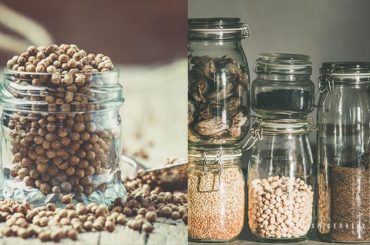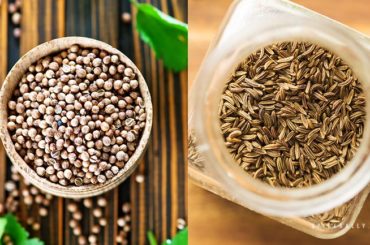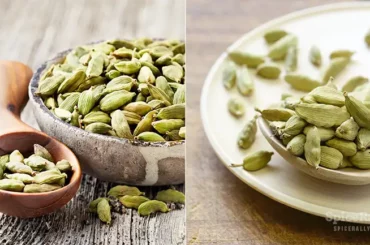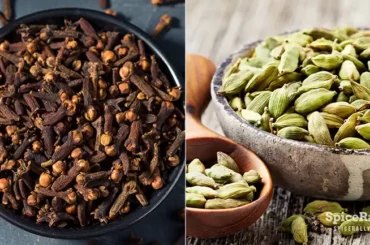Known for its distinctive flavor and aroma, cumin is a widely used culinary spice that packs a punch inside a tiny seed. It does wonders with savory dishes and also spices up sweet treats.
Cumin is the seed of the small flowering plant Cuminum cyminum plant. It is widely used as a spice, mainly in Indian, Sri Lankan, Middle Eastern, North African, and Latin American cuisines. It is loaded with health benefits and adds a warm and nutty taste to many savory and sweet dishes.
So, keep reading our article further if you need to know what is so special about this little guy!
What Cumin Actually Is?
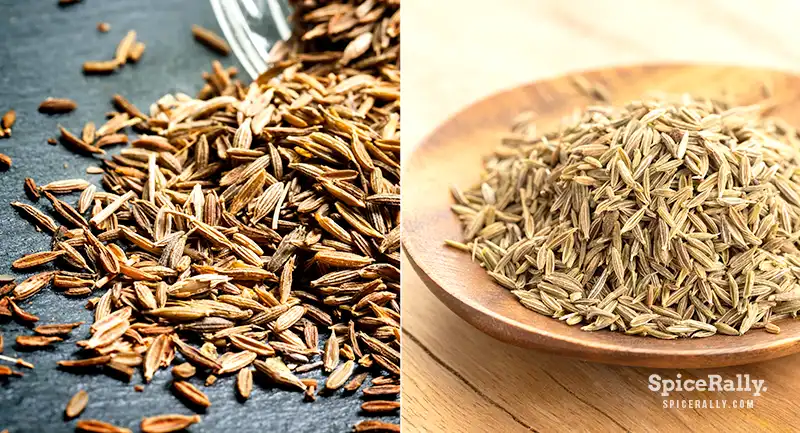
The tiny, brown cumin seed we incorporate into our foods is actually the dried fruit (schizocarps) of a small flowering plant, Cuminum cyminum. This spice belongs to the parsley family and is native to the Mediterranean region.
Cumin seeds are slender, yellowish-brown elongated ovals about 6 mm long. Each seed features five central longitudinal dorsal crests interwoven with less-distinctive secondary elevations composing a tiny grid-like pattern.
Moreover, They possess between 2.5 and 4.5 percent of essential oil (3-4%). And the major active compound of cumin is cumaldehyde. These volatile oils are mostly released in a hot liquid like oil or broth so that its flavor and aroma disperses into our food effectively
History Of Cumin
This spice was initially cultivated in the Mediterranean region and Iran. This is also cited in the bible, and the usage of cumin dates back about 5000 years as a mummification element for the bodies of Egyptian pharaohs.
It has been used to flavor food since ancient Egypt, but the transcripts mention that cumin has been worth more than just a spice.
Ancient Greeks and Egyptians have recorded its value as a medicinal plant. In addition, it has been used as makeup, money and accepted as a charm. While acquiring an interest in modern times, the peak of its popularity was actually in the Middle Ages.
How Does Cumin Taste And Smell Like?
Cumin has a unique taste and a lovely aroma. Although you wouldn’t feel much from whole seeds, ground cumin has a great smell. And, when whole cumin seeds are put into hot oil, the amazing aroma can fill the entire space instantly.
The flavor profile of this spice could be explained as warm and nutty. It is slightly sweet with a touch of earthiness and a citrusy undertone. This delicate flavor profile essentially pairs well with many other ingredients and is very versatile when it comes to cooking and baking.
How Spicy Is Cumin?
To begin with, cumin on its own hardly has any spiciness or hotness. Although it is commonly correlated with heavily spiced foods, it only gets spicy by association. However, this spice ranks on a low spectrum on the heat scale, as 3-4 units which is nowhere compared to spices like cayenne pepper which ranks about eight to nine units.
Is Cumin A Herb Or Spice?
As mentioned previously, cumin is the dried fruit of the Cuminum cyminum plant. Thus, it is considered a spice since it is actually the seeds of this plant.
How To Use Cumin?
Cumin seeds we typically use for culinary purposes come in two main forms: ground and whole. Indian, Sri Lankan, Middle Eastern, and North African cuisines are more familiar with the whole seeds, while Western cuisine relies more on ground cumin.
General Uses
This spice usually adds a depth of flavor to savory dishes, spice blends, and seasoning mixtures. At the same time, it is also used as an excellent flavoring for many desserts, sweets, baked goods, and beverages. Cumin is often used in herbal drinks thanks to its many health benefits.
It has been used since the olden days as an integral ingredient in Ayurveda which is known to balance all “three doshas”: Vata (air/space), Pitta (fire/water), and Kapha (earth/water). Asian households use this valuable spice as folk medicine, incorporate it into their home remedies, and DIY beauty hacks as whole seeds, ground or dry-roasting them.
At present, modern pharmacology has recognized the medicinal value of cumin, so cumin seed powder is produced commercially as tablets/capsules to be taken orally. In addition, you can find pre-made cumin-infused herbal teas, which often combine with other ingredients like lemon, Oolong, honey, and black tea.
Moreover, you can also find cumin essential oil, which can be used with another carrier oil in aromatherapy and is highly beneficial to our health when taken internally.
Cumin Usage In Cooking
Our topic leader is in the spotlight, especially when it comes to Indian, Sri Lankan, Middle Eastern, and Mexican cuisines. In India, cumin is known as “Jeera,” while Sri Lankans call it “Suduru” and is popular by the name “Kamoun” in Middle Eastern countries.
It is usually used in its ground or whole form and sometimes dry-roasted to enhance its flavor and aroma. Indian and Sri Lankan cuisines use ground cumin in most of their primary spice blends, while whole seeds often go into curries, snacks, sweetmeats and sweets (cumin candy is one of their popular sweets), stir-fries, etc.
In addition, Mexican, North African, and Middle Eastern cuisines also use this spice in many of their blends, like Taco seasoning, chili powder, Baharat, Berbere, Ras el Hanout, etc.
And they often use cumin in many of their traditional rice dishes, while ground cumin plays a significant flavoring role when it comes to dry rubs, wet rubs, or meat marinades.
Uses Of Whole Cumin Seeds
As mentioned previously, whole cumin seeds essentially release their volatile oils when put into hot liquids or dry-roasted. This is why Indians use whole cumin seeds as a base for most of their curries and chutneys.
In fact, whole cumin is often tempered in hot oil with other ingredients like mustard seeds, curry leaves, pandan leaves, garlic, and onion.
Other ways to use whole cumin seeds can be:
- When baking certain types of bread, biscuits, and buns
- It can be incorporated into soups, stews, and broths
- With rice dishes
- With meat, seafood, and vegetable dishes
- It is used with certain traditional sweetmeats (Sri Lankan oil cakes, Aluva, Welithalapa)
- Whole cumin seeds are boiled with water and consumed as a healing drink
Uses Of Ground Cumin
Ground cumin is apparently the most used form in Mexican, Middle Eastern, and Western cuisines, along with many other parts of the world. Thanks to the intensified flavor and easily blendable nature of ground cumin, it has become a more versatile ingredient in cooking.
Ground cumin is made by dry-roasting whole cumin seeds and then pulverizing them to a powder. You can make it at home using a grinder or easily buy it from the store since they come under many brands.
Here are some common ways that ground cumin could be used:
- It is a key element in dry rubs, marinades, spice blends, and seasonings
- Used to spice up lentil curries
- It is incorporated into fillings made for sandwiches, burritos, and wraps
- It can be mixed into dips, sauces, and gravies
- To flavor ground meat/ seafood mixtures
- When making certain desserts and baked goods
- To be integrated into beverages and herbal teas
- Ground cinnamon is used in traditional Indian DIY face packs and exfoliators to improve the skin health
The strong aroma of meat, fried onion, cumin, and baked dough soaked into my skin so deeply that I have never lost it. I will die smelling like an empanada.
Isabel Allende.
Why Is Cumin Good For You?
This little spice companion can be good for us in many aspects. Apart from adding a unique zest to our daily dishes, daily consumption of cumin can also bring a massive amount of health benefits to our bodies.
Basically, it contains flavonoids that work as antioxidants that could boost overall immunity. Several clinical research has been conducted over time to demonstrate the medicinal value of this spice by everyday consumption.
Therefore, cumin is considered safe and non-toxic to be incorporated into your diet daily.
Health Benefits of Cumin
Cumin has an active compound known as cumaldehyde and is rich in vitamins E, A, C, K, and B6, along with magnesium, iron, calcium, and phosphorus. Accordingly, this spice could give us the following health benefits:
- Helps to treat diarrhea
- Regulated high blood sugar
- Have potential benefits in lowering cholesterol
- Supports in weight loss
- Boosts memory and brain function
- Improves symptoms of Irritable Bowel Syndrome (IBS)
To discover more benefits you could get from cumin, click on this link and refer to this post.
How To Grow Cumin?
Growing cumin indoors or outdoors at home is not at all challenging since the plants grow well inside containers and outside in your garden. They usually require a long, hot summer of roughly three to four months with a temperature of around 85 degrees Fahrenheit during the day.
Cumin is planted in the spring from seed in rows 2 feet apart in a fertile, well-draining, frost-free, loamy soil. Or else, in cooler temperatures, you can start sowing indoors four weeks before the last spring frost. Plants need to be watered generously and regularly.
It will take around four months for the flowers to bloom. And when it is ready to harvest, the seeds should be gathered by hand.
Cumin Replacements (Substitutes For Cumin)
Cumin could be a staple in your kitchen, but sometimes there could be instances where you could run out of it unknowingly.
It is true that there’s nothing quite like this little guy which could give the exact same taste and aroma. But still, a handful of perfect substitutes could come to your rescue. And they are:
- Fennel seeds
- Caraway seeds
- Whole coriander seeds or ground coriander seeds
- Curry powder
- Garam Masala
- Chili powder
- Taco seasoning
How To Store Cumin?
Like every other spice or herb, cumin also tends to lose its potency over time. But, by storing it in the right containers and places, you can preserve this spice for a longer period.
Cumin does not actually go bad, but it will lose its flavor and aroma with time. So, it would be best if you store your whole cumin seeds, ground, or dry-roasted cumin seeds in a tightly-sealed container and keep them in a safe place in your pantry or spice cabinet with zero direct sunlight, humidity, or moisture.
In this way, your whole cumin seeds will stay well for up to 3-4 years, while ground cumin will be fragrant and flavorful for up to one year. As the general rule of thumb, whole seeds tend to stay fresher for longer compared to the ground spice.
So, if you purchase cumin for household purposes, it is wise to buy it in small batches. However, refrigeration is not considered a very favorable storing method for dry spices like cumin.
Cumin Is A Mighty Spice That Deserves A Place In Your Pantry!
Predominantly used in Indian, North African, Middle Eastern, Sri Lankan, Latin American, and Indian cuisines, cumin has its own way of enlivening our dishes. Its delicate yet powerful flavor and aroma profiles enhance the quality of food and give us the goodness of its tremendous health benefits.
Cumin is readily available in the store as whole seeds and ground form, which is helpful in culinary use. In addition, you can also get it as a tea infusion, tablet./capsule, or essential oil. This is one of the most versatile spices that could complement many sweet and savory dishes, sweets, and beverages.

